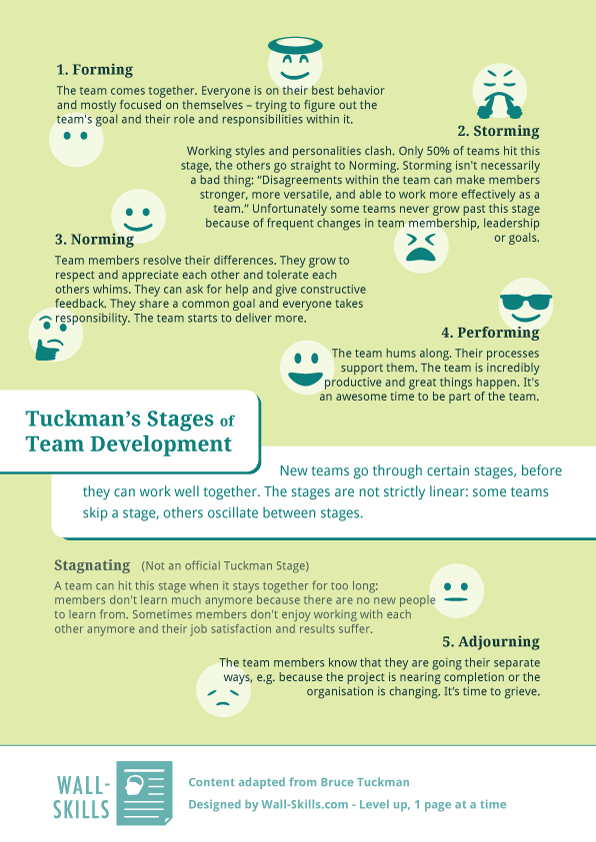In 1965, Bruce Tuckman derived that all newly formed teams go through similar stages, before they can perform well together. He laid it out in his paper “Developmental Sequence in Small Groups” (Paywall). The stages are not strictly linear. Some teams skip a stage, others fluctuate e.g. because of changes in team membership, leadership, tasks, …
The original four stages are Forming, Storming, Norming and Performing. Tuckman himself later added a final stage: Adjourning.
Lately, I hear a lot of suggestions for another stage inbetween “Performing” and “Adjourning”. I’ve first heard about it from Heidi Helfand. She calls it “Stagnating”. This stage highlights the trade-off between keeping teams stable (you don’t have to go through the stages again) and too stable (stagnating).
Recent research (that I’ve unfortunately lost the link to 🙁 ) suggests that the stages are not as clear-cut as laid out by Tuckman. Instead, a team can be in several stages at the same time – the stage depends on the topic. So, they might be performing in writing code and still storming about how to best test this code. The phases are still a useful model just more granular than previously thought.
Are you a budding Product Owner? Check out our compilation "Skills for Successful Product Owners"
Content of 1-Pager:
Tuckman’s Stages of Team Development
New teams go through certain stages, before they can work well together. The stages are not strictly linear: some teams skip a stage, others oscillate between stages.
1. Forming
The team comes together. Everyone is on their best behavior and mostly focused on themselves – trying to figure out the team’s goal and their role and responsibilities within it.
2. Storming
Working styles and personalities clash. Only 50% of teams hit this stage, the others go straight to Norming. Storming isn’t necessarily a bad thing: “Disagreements within the team can make members stronger, more versatile, and able to work more effectively as a team.” Unfortunately some teams never grow past this stage because of frequent changes in team membership, leadership or goals.
3. Norming
Team members resolve their differences. They grow to respect and appreciate each other and tolerate each others whims. They can ask for help and give constructive feedback. They share a common goal and everyone takes responsibility. The team starts to deliver more.
4. Performing
The team hums along. Their processes support them. The team is incredibly productive and great things happen. It’s an awesome time to be part of the team.
Stagnating (Not an official Tuckman stage)
A team can hit this stage when it stays together for too long: members don’t learn much anymore because there are no new people to learn from. Sometimes members don’t enjoy working with each other anymore and their job satisfaction and results suffer.
5. Adjourning
The team members know that they are going their separate ways, e.g. because the project is nearing completion or the organisation is changing. It’s time to grieve.
Sources:
- Wikipedia
- Mindtools
- Original paper by Tuckman: “Developmental Sequence in Small Groups” (Paywall)
- Suggestion for Stagnating by Heidi Helfand

